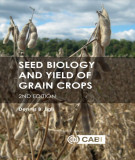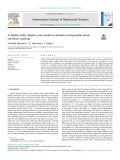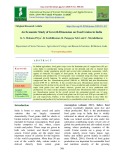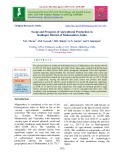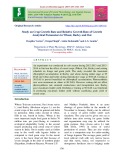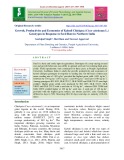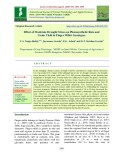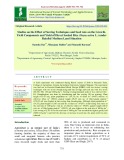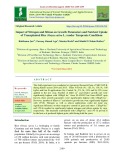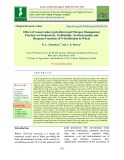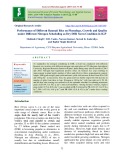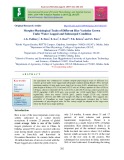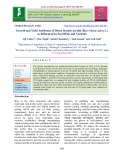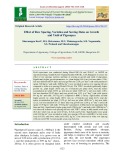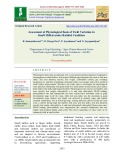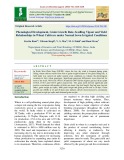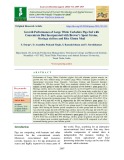
Grain growth rate
-
Ebook "Seed biology and yield of grain crops (2nd edition)" of an established title examines the determination of grain crop yield from a unique perspective, by concentrating on the influence of the seed itself. As the food supply for an expanding world population is based on grain crops harvested for their seeds, understanding the process of seed growth and its regulation is crucial to our efforts to increase production and meet the needs of that population.
 233p
233p  lucchinguyen
lucchinguyen
 28-12-2023
28-12-2023
 12
12
 2
2
 Download
Download
-
The model showed matching results for all duplex oxide combinations in varying stress, but the inner logarithmical oxide gave higher crack growth rates than the power law. The power law with the thicker inner oxide showed good results for the change of stress intensity factor and gave the best results when the yield stress was varied. Grain misorientation effect was higher for the duplex oxides with thicker outer oxides.
 16p
16p  guernsey
guernsey
 28-12-2021
28-12-2021
 6
6
 0
0
 Download
Download
-
The study on growth and yield of chickpea (Cicer arietinum L.) as influenced by seed rate and seed priming was conducted during Rabi 2017-18. The experiment consisted of nine treatment combinations of three seed rates viz. 60 kg, 80 kg and 100 kg ha-1 in main plots and three seed priming treatments viz. control, water and NaCl in sub plots were tested in split plot design with three replications.
 6p
6p  chauchaungayxua10
chauchaungayxua10
 18-03-2021
18-03-2021
 11
11
 2
2
 Download
Download
-
In Indian agriculture, food grain crops cover the dominant part of cropped area (65 per cent). India is continuously facing pressure on the demand side due to limited land availability, steady population growth and several other production constraints, which appear as obstacles for supply of food grains. In the present study, growth in area, production and productivity of food grains were estimated using the linear trend and compound growth function.
 9p
9p  chauchaungayxua11
chauchaungayxua11
 23-03-2021
23-03-2021
 13
13
 1
1
 Download
Download
-
The present study was conducted in Kolhapur district of Maharashtra state during 1980-81 to 2011-12. The study found that area under wheat, bajra, gram, redgram had declined and area under rice, Kharif jowar, Rabi jowar, greengram, blackgram, fruits and vegetables, soybean sugarcane and groundnut was increased. Similarly area under total cereal and pulse was also declined.
 8p
8p  cothumenhmong9
cothumenhmong9
 18-01-2021
18-01-2021
 18
18
 1
1
 Download
Download
-
An experiment was conducted in rabi season during 2012-2013 and 2013- 2014 to find out the effect of cereal crops (Wheat, Oat, Barley) and cutting schedule on forage and grain yield. The study revealed the maximum chlorophyll accumulation in Barley and wheat during initial stage at 95 DAS and wheat and barley during reproductive stage at 30 DAS. Cutting at 50 DAS is proved beneficial on chlorophyll accumulation. Photosynthetic rate were maximum in wheat at 90 DAS.
 7p
7p  angicungduoc8
angicungduoc8
 07-11-2020
07-11-2020
 20
20
 3
3
 Download
Download
-
Seed is a basic and costly input in agriculture. Genotypes of a crop varying in seed size and growth behaviour may differ in optimal seed rate for realizing high grain yields. Field experiments were conducted for three years at Punjab Agricultural University, Ludhiana, India to study the growth, productivity and economics of kabuli chickpea genotypes in response to seeding rate.
 14p
14p  nguaconbaynhay8
nguaconbaynhay8
 13-10-2020
13-10-2020
 10
10
 1
1
 Download
Download
-
In the changing climate scenario, drought could be continued as a major abiotic limitation for crop productivity. Finger millet although known for its drought tolerance, the drought stress decreases the grain yield from 25 to 100 percent depending on the duration and magnitude of drought stress. Present study was conducted to explore the genetic variability of selected genotypes over the ruling varieties if any, based on the extent of reduction in grain yield, and dependent photosynthetic traits due to moderate drought stress for 18 to 20 days (grand growth to flower primordial initiation).
 9p
9p  kethamoi7
kethamoi7
 26-08-2020
26-08-2020
 13
13
 1
1
 Download
Download
-
A field experiment was conducted during Kharif season of 2016 at Research Farm, College of Agriculture, Central Agricultural University, Imphal, Manipur. The experiment was laid out in Factorial Randomised Block Design (FRBD) with two factors: sowing techniques with two levels (broadcasting and line sowing) and seed rate with five levels (80, 90, 100, 110 and 120 kg ha-1 ).
 14p
14p  caygaocaolon6
caygaocaolon6
 30-07-2020
30-07-2020
 18
18
 2
2
 Download
Download
-
The field experiment was conducted at Agronomy Research Farm of SKUAST-K during Kharif season 2014 and 2015. Three N levels (N1: 120, N2: 150, N3: 180 kg/ha) and four Si applications (Si0: Control, Si1: 5%, Si2: 10% and Si3:15%) were applied to the rice crop. Number of tillers m-2 and relative growth rate were significantly highest with 180kgN ha-1 from 30-45DAT but from 60DAT upto harvest, these growth parameters were significantly highest with 120kgN ha-1 . However, number of tillers m-2 and relative growth rate were significantly highest with 15%Si.
 7p
7p  angicungduoc6
angicungduoc6
 22-07-2020
22-07-2020
 8
8
 1
1
 Download
Download
-
A field experiment was carried out at ICAR-Indian Agricultural Research Institute, New Delhi for two consecutive years to evaluate the effect of conservation agricultural and nitrogen management practices on productivity, profitability, nutrient-uptake and response functions of N-fertilization in wheat in maize-wheat cropping system. There were six main-plot treatments of tillage and crop establishment techniques, i.e.
 13p
13p  angicungduoc6
angicungduoc6
 22-07-2020
22-07-2020
 20
20
 1
1
 Download
Download
-
To standardize the nitrogen scheduling in DSR, a field was conducted with different Basmati rice varieties with different nitrogen rates and splits at CCS Haryana Agricultural University, Regional Research Station at Karnal, India during rainy kharif seasons of 2014 and 2015. Nitrogen had significant positive effect on basmati rice crop resulting in improvement in plant height, number of tillers and effective tillers, grains/panicle, panicle length, 1000-grain weight, grain yield and straw yield with increase in dose from 90 to 100 and 110 kg ha-1 in succession.
 8p
8p  chauchaungayxua6
chauchaungayxua6
 26-06-2020
26-06-2020
 15
15
 1
1
 Download
Download
-
An experiment was conducted to evaluate morpho-physiological traits of different rice varieties grown under water logged and submerged condition during Kharif- 2012, showed maximum number of inter-node (more than 3cm) in stem (6.85), adventitious root (4.23), plant height at 90 days (135.53 cm) and (152.33 cm) at 150 days, number of tillers (9.20) at 120 days, effective tillers/hill (8.74), LAI (4.91), LAR (58.78 cm2 /g), relative growth rate (38.93 mg/g/day), LWR (0.30 g/g), crop growth rate (11.66 mg/m2 /day), NAR (40.95 mg/dm2 /day, shoot dry matter (1145.0 g/m2 ), panicle length (27.
 13p
13p  nguaconbaynhay6
nguaconbaynhay6
 24-06-2020
24-06-2020
 13
13
 1
1
 Download
Download
-
The present investigation was conducted during kharif season of 2014 at N.E. Borlaug Crop Research Centre of G.B. Pant University of Agriculture and Technology, Pantnagar (Uttarakhand) to optimizing the seed rate of hybrid and high yielding varieties of rice under direct seeded aerobic condition. Treatments were tested in a split plot design with three replications keeping varieties in main-plots and seed rates in sub-plots.
 6p
6p  nguaconbaynhay6
nguaconbaynhay6
 24-06-2020
24-06-2020
 8
8
 0
0
 Download
Download
-
A field experiment entitled “Effect of soil application of silicon on growth and yield attributes of rice (Oryza sativa L.) was conducted in Kharif season 2017-18. Soil application of silixol granules was given at the time of mid-vegetative, mid-reproductive and mid-ripening stages of rice. The experiment was arranged as randomized block design with four treatments which replicated thrice.
 7p
7p  angicungduoc5
angicungduoc5
 14-06-2020
14-06-2020
 13
13
 1
1
 Download
Download
-
Karnataka state has a typical composition having a large share of its area under highly diversified agricultural crops, higher growth in agriculture assumes great importance and is a matter of concern for policy planners and research scholars in recent times. The analysis of growth is usually used to find out the trend of a particular variable over a period of time and used for making policy decisions.
 4p
4p  cothumenhmong5
cothumenhmong5
 17-05-2020
17-05-2020
 14
14
 2
2
 Download
Download
-
Field experiment was conducted during Kharif-2015-16 and 2016-17 at AICRP on Agrometeorology, Gandhi Krishi Vignana Kendra (GKVK), UAS, Bangalore to assess the effect of row spacing, varieties and date of sowing on growth and yield of pigeonpea. Significantly higher growth parameters viz., plant height (165.4 cm), leaf area index (2.10), leaf area duration (60.34 days) and crop growth rate (2.39 g m-2 day-1 ) and yield parameters (grain: 940 kg ha-1 and stalk: 4089 kg ha-1 ) were recorded in narrow row spacing (60 cm) compared to wider row spacing (90 and 120 cm).
 6p
6p  cothumenhmong5
cothumenhmong5
 17-05-2020
17-05-2020
 17
17
 1
1
 Download
Download
-
Physiological traits play an important role in crop growth and development. Comparative investigation on small millets, with respect different physiological traits such as leaf area index, leaf area duration, specific leaf weight, chlorophyll content, gas exchange parameters etc. and their relationship with grain yields were meager, and will be useful in small millets improvement.
 14p
14p  trinhthamhodang5
trinhthamhodang5
 16-05-2020
16-05-2020
 9
9
 1
1
 Download
Download
-
In North West Plain Zone (NWPZ), where the hot, dry wind is frequent during grain filling, wheat cultivars suffer from loss of grain weight because of low grain filling rate. A field study was carried out under normal sown conditions to evaluate the phenological variation in forty wheat genotypes. Significant genotypic differences were observed for most of the traits. WH 1105, WH 1138 and HD 2967 had the highest grain yield per plant 1150.0, 1136.7 and 1103.3 g/plot respectively.
 9p
9p  nguaconbaynhay5
nguaconbaynhay5
 11-05-2020
11-05-2020
 9
9
 1
1
 Download
Download
-
Performance of Large White Yorkshire piglets fed with alternate protein sources on growth rate were studied using 24 weaned Large White Yorkshire piglets available at Instructional Livestock Farm Complex, Veterinary College and Research Institute, Namakkal for 120 days period. They were randomly allotted into 4 treatments with 6 animals in each group to study the effect of inclusion of wet brewer’s spent grains (T1)...
 11p
11p  quenchua4
quenchua4
 06-04-2020
06-04-2020
 12
12
 1
1
 Download
Download
CHỦ ĐỀ BẠN MUỐN TÌM









